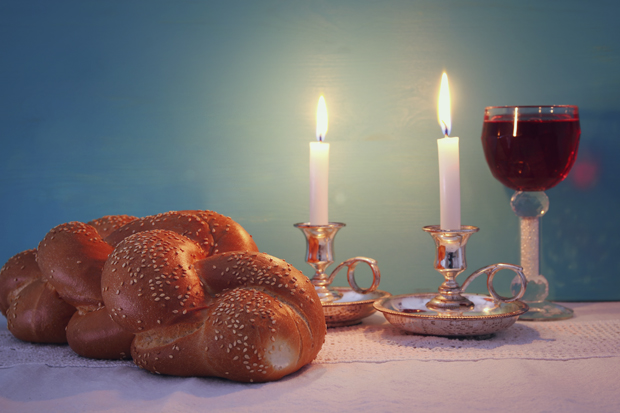A very Stockholm Shabbat
President Liebowitz, Brandeisians and the Stockholm Jewish community gathered for Shabbat during Nobel Week

Surrounded by portraits of prominent Swedish rabbis and Jews, the Liebowitzes welcomed the Sabbath before a gathering of about 125, which included Sweden-based alumni, members of the Stockholm Jewish Community, members of the Sweden-American Foundation, and two current Brandeis undergraduates who are studying in Stockholm this semester.
“It’s really a remarkable thing that we’re here celebrating with the Stockholm Jewish community and Brandeis alumni and friends,” Liebowitz said.
“There was a great deal of joy among the alumni,” said Annika Schildt ’86, a Wien International Scholar who attended the Shabbat dinner. “Everyone appreciated that Brandeis let us meet the laureates we are so proud of during an evening with interesting speeches and exquisite food in good company.”
The Shabbat dinner took place at the social hall of the organization, Judiska Församlingen (Jewish Community). After Ron gave introductory remarks, the congregation’s rabbi offered a warm Shabbat welcome, and a member of the congregation recited the Kiddush, the traditional prayer said over the wine. Ron and Jessica Liebowitz then said HaMotzi, the ceremonial blessing over the challah. Before dinner was served, the chairman of the board of the Jewish Community of Stockholm extended his warm welcome and provided an abbreviated history of Jews in Stockholm.
Brandeis’ two Nobel prize winners, Michael Rosbash, the Peter Gruber Endowed Chair in Neuroscience, and Jeff Hall, emeritus professor of biology, together with their families, attended the event. Rosbash and Hall discovered the molecular mechanisms controlling circadian rhythms, the inner biological clock that regulates almost all life. (Michael Young of Rockefeller University shared the award for his research on circadian rhythms.)
With the announcement of Rosbash and Hall’s Nobel Prize in Physiology or Medicine in October, the Brandeis community “began reflecting on the qualities that nurture the kind of imagination that leads to a Nobel Prize,” Liebowitz said in comments to the guests after dinner.
“Our founders were visionary in their insistence on creating a university based on academic excellence and animated by values rooted in Jewish history and experience. Reverence for learning is chief among these values,” he told the gathering, which included Eve Marder, the Victor and Gwendolyn Beinfield Professor of Neuroscience; and Leslie Griffith, the Nancy Lurie Marks Professor of Neuroscience, who are part of the Brandeis contingent in Stockholm to celebrate Nobel Week.
“Brandeis is also distinguished by the intellectual environment in which professors Rosbash and Hall made their discoveries,” Liebowitz noted. “Our science division is interdisciplinary and open-minded and deeply collaborative.”
In his remarks after dinner, Hall recounted his days in the early 1970's “toiling in obscurity” as a postdoctoral fellow at Caltech when he got a call from a Brandeis assistant professor. He asked Hall if he’d like to teach at Brandeis.
Hall said he was drawn to the vision of Brandeis for three reasons: First, it was a small but significant university — “uppercase U”— that emphasized both teaching and scholarship; second, its location was very close to Boston, a “great, world-class city”; and third, it was “named for one of the three greatest Americans of all time: Louis Dembitz Brandeis.”
Following Hall’s remarks with his own, Rosbash called his longtime collaborator “the only Episcopalian who knows the difference between schlemiel, schlimazel and schmendrik.”
He, too, attributed much of his success to Brandeis’ combination of a liberal-arts college with world-class, university-level research. “I would never, ever, ever, ever be standing here if I had taken a job at another university,” said Rosbash, who joined Brandeis in 1975.
Stockholm’s Jewish community dates to at least the 15th century, when Jews began arriving in Sweden from elsewhere in northern Europe, but none were allowed to acquire permanent residency until 1774. Over the years, Jews played a major role in bailing out the Swedish crown when it went into deep debt, insisting on greater rights and privileges in exchange for the money. In the late 1860s, the Jewish community built the Great Synagogue, to which four decades later was added the building in which the Shabbat dinner was held.
After World War II, Jewish refugees from the Baltic countries, Romania, and Poland settled in Sweden; decades later Jews fled communism in Eastern Europe for Sweden. Today there are roughly 20,000 Jews in Sweden, 4,500 of them in Stockholm.
Categories: Alumni, International Affairs, Research





